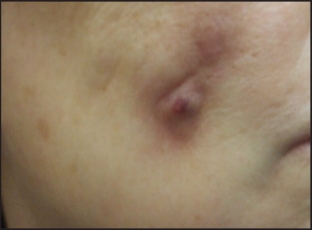Complications after filler injections – this is as much a discussed and important topic in modern aesthetic medicine as the contouring procedure itself. About biofilm as a consequence of the introduction of fillers, they started talking not so long ago, but it is this complication that requires special attention of estheticians. Formation after injection procedures of such inflammatory nodular elements as bacterial biofilms – is not such a rare occurrence today, which is why it is so important for doctors to know how to deal with this problem. In today's material on estet-portal.com, read in detail about the methods of diagnosis, treatment and prevention of bacterial biofilms.
What are bacterial biofilms and how dangerous are they
The concept of biofilm refers to a conglomerate of microorganisms tightly attached to each other, and often immersed in an extracellular polymeric substance synthesized by them.
Bacterial biofilms can cause local and systemic infection, inflammatory and granulomatous reactions.
The process of biofilm development is called biofouling, and a mature bacterial biofilm can release individual free-floating bacteria into the environment. The development of a bacterial biofilm after fillers requires the adoption of certain measures, because the longer the biofilm exists, & nbsp; the more resistance to antibacterial drugs it acquires.
Bacterial biofilms:
- what methods will help diagnose bacterial biofilm;
- Conservative and surgical treatments for bacterial biofilms;
- effective methods to prevent bacterial biofilm.
What methods will help diagnose bacterial biofilm
A specialist can suspect the formation of a biofilm in a patient if, at any time after the injection of the filler, a red, infiltrated zone appears, the nature of the course of this inflammatory focus is persistent, and there is no response to treatment. Cultural diagnosis of biofilms is not effective – cultures are negative, but the fluorescent in situ hybridization technique confirms the infectious nature of the complication. An effective method for diagnosing bacterial biofilms is also scintigraphy with radiolabeled autologous leukocytes.

Conservative and surgical treatment of bacterial biofilms
First of all, when a bacterial biofilm is formed after the injection of fillers, the patient is prescribed systemic broad-spectrum antibacterial drugs, namely, macrolides and quinol antibiotics. If a bacterial biofilm has formed around an excess amount of a biodegradable or non-biodegradable filler, removal of the filler will help reduce the post-inflammatory response. When working with hyaluronic fillers, hyaluronidase is used. If the site of indurative inflammation continues to exist, it is recommended to administer foci of 5-fluorouracil (monovariant or in combination with steroids) at intervals of 2-4 weeks. If the above treatments are ineffective – hardware techniques are used: laser or radiofrequency lysis.
Effective methods for preventing bacterial biofilmMethods for preventing the development of bacterial biofilm – these are very simple recommendations, the implementation of which will help specialists
avoid unpleasant complications. These include:
- careful cleaning of the future injection area with a high-quality disinfectant;
- restriction of the administration of drugs through the mucous membranes of the mouth and nose;
- exclusion of the injection of the filler into the traumatized tissue, or at the site of the previous injection;
- restriction on the use of hydrophilic permanent materials;
- avoid aggressive inappropriate treatment of any infections after fillers.
It is believed that 95-99% of all microorganisms that exist in the natural environment are in the form of a biofilm, but its formation after filler injections can become a serious threat to the body.Proper prevention of bacterial biofilm formation will help to avoid the development of this complication. Estet-portal.com thanks you for your attention.
See also:
"Nodular formations after filler injections: causes, treatment and prevention".







Add a comment